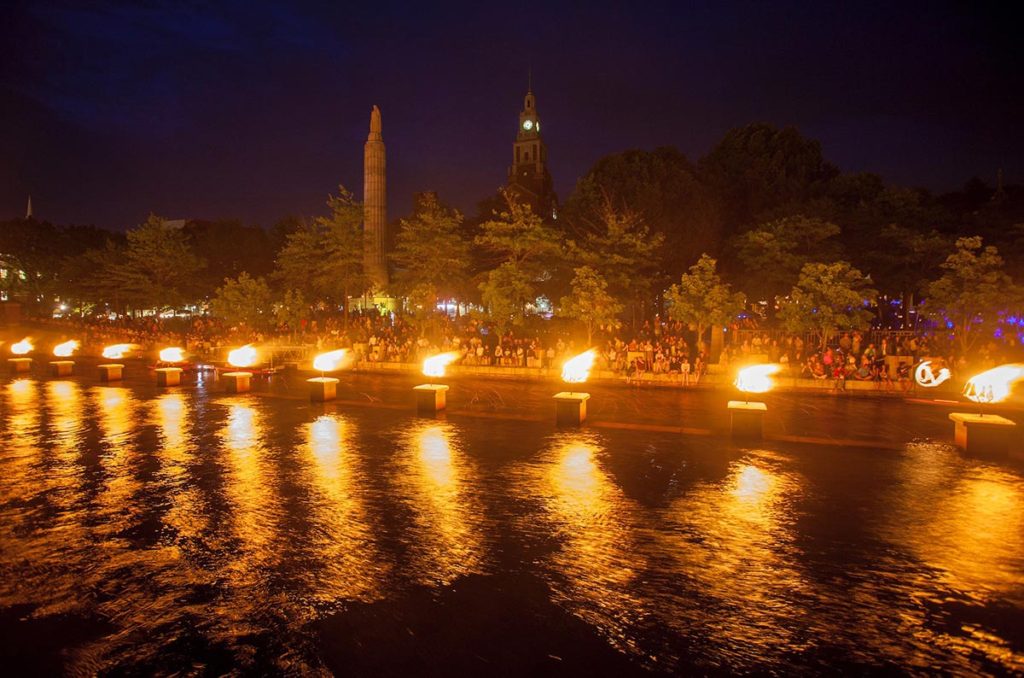
One evening several years ago as we strolled along a pedestrian bridge in Lyons on the eve of the Summer Solstice, my husband and I were captivated by the sight and sounds of thousands of people walking along the river, listening to the sounds of music emanating from musicians on barges below. As we mingled with the crowd, sharing a sense of joy and community, we learned that the French celebrate National Music Day at this time every year. We knew we were sharing a very special moment, one that we thought we could experience again only by returning to Lyons on a Solstice evening.
But a few years later on our own turf we came upon an equally compelling event in a setting that would have been unimaginable a few years before. Following up on the word that an artist was going to be lighting fires on the river as part of the International Sculpture Conference and the city’s Convergence Festival, we joined the throngs of curious citizens undaunted by riverbank construction to see Barnaby Evans’ installation Second Fire. Thirty-two fires tended by black-clad boat crews blazed from sunset to midnight, accompanied by haunting musical chants. Spreading the word to all who would listen, we returned the next evening to see even more people gathering to witness the passing of the Olympic Torch. Thousands converged on a too often empty downtown to gaze at the fires, the setting and the city with new eyes and a sense of excitement, euphoria and civic pride. “It’s so beautiful, it smells so good, I can’t believe that we’re in Providence!” became the mantra, and I, like so many others who fell under WaterFire’s spell, was determined not to let this magic get away!
A friend and I learned that artist Barnaby Evans, who had installed a smaller version of his fire sculpture in the WaterPlace Basin on First Night the previous year, had planned Second Fire as a temporary installation. Convinced that this could be a signature piece for the city and one that would generate a sense of civic pride in its citizenry, we set out to help weave this public art into the fabric of the city’s Renaissance. With so many who had experienced the fires already enthusiastic supporters, many volunteers were willing to join the project. Our first challenge was to convince Barnaby that it would be possible to raise the funds to construct the sculpture of durable materials and expand and operate the project.
Thanks to a grass roots effort and the dedication of hundreds of volunteers, WaterFire was established as a non-profit arts organization. It soon became a focal point for thousands of Rhode Islanders reconnecting with their capital city, and a destination for tourists who a few years earlier might have quickly driven by on their way to the Cape. It is not only a beautiful art work that engages all our senses but it demonstrates the power of public art to bring people into the city – to enjoy the urban landscape – to walk instead of drive. It serves as an economic generator for the city and a cultural catalyst for other performing arts groups. It has achieved enormous national and international critical acclaim including a citing by the New York Times as “the most evocative of all quasi-primitive Millennium rites anywhere” and the Providence Journal has called it “the most popular work of art in the capital city’s 361-year history.”
At times WaterFire has been threatened by its own popularity, requiring strategies to deal with crowd control on land and water. As a cultural catalyst WaterFire draws people to theater and dance productions in WaterPlace Park as well as events staged throughout the city. The Sovereign Ballroom, whose shiny black floor covers the cobblestone street adjoining the sculpture plaza, draws crowds to tango, waltz, salsa or fox trot, and the Verizon Jazz Stage features live jazz in a cabaret setting at the foot of College Hill, both enhancing the WaterFire experience. Food vendors are stationed at key spots to provide food and drink to thousands of hungry visitors. Gondolas and tour boats enable visitors to have a close-up view and a fleet of Thai boats is frequently used for sculptural displays.
No longer do I worry that the crowds might not come, but when I see the crowded city streets thronged with an armada of strolling young and old, with picnic baskets and looks of anticipation on their faces, my heart still leaps. I recall the magic of a night in France, delighted that in Providence we don’t have to wait a year for the next presentation of WaterFire.
– Joan Slafsky
Joan Slafsky, along with Jeanne Sturim, were responsible for convincing Barnaby Evans that it was possible to continue his 1996 fire installation as an on-going arts installation. Slafsky then worked to make it happen and served on the Board until January of 2020. This essay was originally written for Reflections on WaterFire a series of stories and essays written by local thought leaders to mark the 100th lighting of WaterFire on September 1, 2001.
